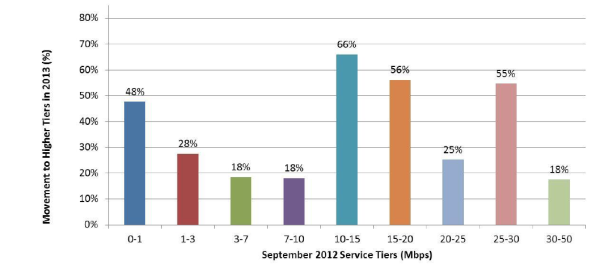Last week, in opening an informal inquiry into matters related to Internet interconnection and traffic exchange, Chairman Wheeler stated: “Consumers must get what they pay for. As the consumer’s representative we need to know what is going on.”
Today, with the release of the fourth Measuring Broadband America report, the Commission demonstrates that consumers do, in fact, “get what they pay for” when they purchase broadband Internet access service. The report’s findings, which are based on over 8 billion measurements, underscore that the U.S. enjoys a healthy, growing, and competitive broadband marketplace.
The good news from a cable perspective is that providers are delivering speeds that consistently meet or exceed advertised numbers. At peak period, the FCC found that cable-based services delivered 102 percent of advertised download speeds and 111 percent of advertised upload speeds. Moreover, the FCC concluded that these results “demonstrate that consumers should be reasonably confident that the performance they receive from their ISP will be consistent with the results reflected in this Report.”
The bottom line is that NCTA’s members continue to hit the mark in delivering a quality, high-speed Internet experience. Another key element of the FCC report shows that consumers have moved into higher speed tiers. This may seem like an obvious point (of course people want more speed), but looking to the chart below, the significant jumps of the 10 – 15, 15 – 20 and 25 – 30 Mbps bands demonstrate not just the value of speedy broadband Internet, but is an indicator of the relative affordability of these increased tiers. Many of these speed migrations have been the result of cable providers increasing the speeds of existing service tiers at no additional charge, and those speed increases have continued into 2014.

The improved popularity of high-speed tiers is also reflective of the fact that broadband providers are consistently working to improve service, quality, and reach. So perhaps the most important takeaway of the Commission’s study is the clear evidence that consumers are reaping the benefits of faster and more robust broadband connections. We hope that this latest report again helps to refute the unsubstantiated allegations that cable operators routinely under-deliver and are solely responsible for any deficiencies in the performance experienced by consumers.Since the Commission started this effort back in 2010, the cable industry has voluntarily submitted to rigorous third-party testing and established a consistent track record of outstanding performance.
The Measuring Broadband America report also highlights the need for additional information regarding aspects of the Internet other than access service provided by ISPs. As the report explains, the Commission has only been measuring performance over the local access network, and there are many other factors beyond an ISP’s control – upstream congestion or performance limitations of computers or Wi-Fi routers to name a few – that also affect the consumer Internet experience. As the FCC strives to provide consumers with accurate and useful information, the Commission should be clear about the limited scope of the data released and it should seriously consider the value of additional, more holistic testing approaches that might better inform consumers about the variety of factors that affect Internet performance.
